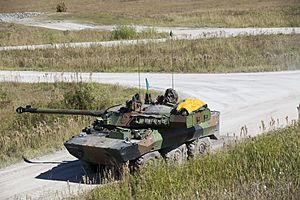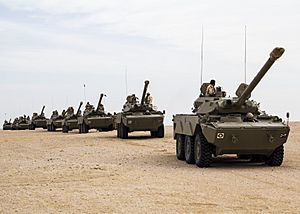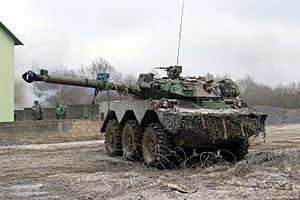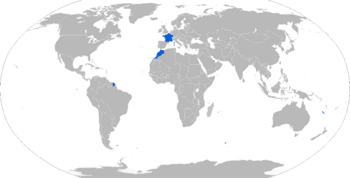AMX-10 RC facts for kids
Quick facts for kids AMX-10 RC |
|
|---|---|
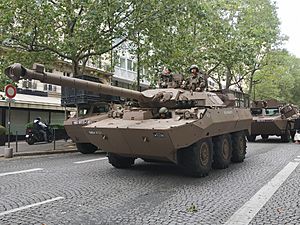
A French Army AMX 10 RCR after the Bastille Day Parade (July 14, 2021)
|
|
| Type |
|
| Place of origin | France |
| Service history | |
| In service | 1981–present |
| Wars |
|
| Production history | |
| Designed | 1970 |
| No. built | 464 |
| Specifications | |
| Mass |
|
| Length |
|
| Width | 2.78 m (9 ft 1 in) |
| Height | 2.56 m (8 ft 5 in) |
| Crew | 4 |
|
|
|
| Armor |
|
|
Main
armament |
105 mm F2 BK MECA L/47 medium-pressure gun (38 rounds) |
|
Secondary
armament |
|
| Engine |
|
| Power/weight | from 11.8 kW/tonne |
| Suspension | variable hydropneumatic |
|
Operational
range |
800 km (500 mi) on road |
| Maximum speed |
|
The AMX-10 RC is a French armoured fighting vehicle. It was built by Nexter Systems. This vehicle is mainly used for armoured reconnaissance, which means scouting and gathering information in dangerous areas.
The French Army has used the AMX-10 RC since 1981. In 2021, over 240 of these vehicles were still in service in France. Other countries like Morocco and Qatar also bought them. The "RC" in its name stands for "Roues-Canon", which means "wheeled gun" in French. It is often called a wheeled tank destroyer because it has a powerful gun on wheels. Some people also call it a light tank.
The AMX-10 RC is different from another vehicle called the AMX-10P. Even though they share some parts, they have very different jobs on the battlefield. The AMX-10 RC is mostly used for scouting missions in risky places or to provide fire support to other troops.
Since 2021, the French Army has started to replace the AMX-10 RC with a newer vehicle called the EBRC Jaguar.
Contents
What is the AMX-10 RC?
The AMX-10 RC is a special military vehicle that combines speed and firepower. It's designed to move quickly on wheels, unlike tanks that use tracks. This makes it good for fast reconnaissance missions. It also carries a strong gun to defend itself or support other units.
How was it designed?
Work on the AMX-10 RC started in 1970. The first test vehicles were ready in 1976. The very first AMX-10 RC was delivered to the French Army in 1981.
The vehicle has a powerful 105 mm gun. This gun is placed in a strong turret made of aluminum. Three crew members work inside the turret, while the driver sits in the front part of the vehicle. A special system helps the crew aim the gun accurately. The AMX-10 RC has a six-wheel drive system. It turns by using skid steering, which means it slows down wheels on one side to pivot.
What kind of engine does it have?
The AMX-10 RC first used a Hispano-Suiza HS 115-2 engine. This engine was powerful, providing 250 horsepower.
Later, in 1985, a different engine was chosen for new AMX-10 RC vehicles. This new engine was the Baudouin 6F11 SRX diesel engine. It was also used to upgrade older vehicles in the French Army. This engine provides 300 horsepower, but it was set to run at 250 horsepower for the French Army.
The vehicle has a 24-volt electrical system. It also used to have two water jets for moving in water, but these were later removed.
How does it move?
The AMX-10 RC uses a special gearbox to change speeds. It has four forward gears and four reverse gears. This gearbox helps the vehicle move smoothly.
The vehicle's suspension system is very advanced. It's called a hydropneumatic system. This allows the vehicle to change how high it sits off the ground. It can also tilt, which helps it move over different types of terrain. Each wheel has a shock absorber to make the ride smoother.
What weapons does it carry?
The main weapon of the AMX-10 RC is a 105 mm gun. This gun is in a turret that holds three crew members. The gun fires special 105 mm ammunition. It uses an electrohydraulic system to control how the gun moves.
Besides the main gun, the AMX-10 RC also has a 7.62 mm machine gun. This machine gun is mounted next to the main gun. It also has smoke grenade launchers on each side of the turret. These launchers can create a smoke screen to hide the vehicle. The vehicle carries 38 main gun rounds, 4,000 rounds for the machine gun, and 16 smoke grenades.
The 105 mm gun can fire different types of ammunition. One type is called APFSDS, which is good for piercing armor. Another type is High-Explosive (HE), which is good for general targets. There's also a HEAT-FS round, which is effective against armor, and a practice round for training.
How has it been updated?
The AMX-10 RC has been updated many times over the years. For example, its night vision systems were improved. During the 1991 Gulf War, it received extra armor to protect it better. Its muzzle brake, which helps reduce the gun's recoil, was also improved.
The vehicle's ability to float in water and its water pumps were removed in later versions. A modern battlefield management system was added to help the crew with communication and planning. There were ideas to give it an even more powerful 105 mm gun, but this was not done. The AMX-10 RC also has a system to protect the crew from chemical, biological, and nuclear threats.
AMX-10 RCR Modernization
In 2010, a major upgrade program was completed for 256 AMX-10 RC vehicles. These upgraded vehicles are called AMX-10 RCR. The "RCR" stands for "Rénové", meaning "renovated" or "modernized."
This upgrade added many new systems. It included more armor and active self-protection systems. It also got a new battlefield management system and improved smoke grenade launchers. The NBC protection system was updated, and the suspension was improved. The communication systems were also made better.
Different Versions
- AMX-10 RC: This is the first version that was produced. It could originally move in water.
- AMX-10 RC surblindé (uparmored): This version has extra armor added to it. It cannot move in water.
- AMX-10 RCR revalorisé (upgraded): This is the modernized version with many new systems and improvements.
Where has it been used?
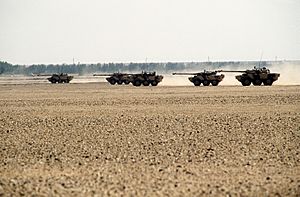
The French Army has used the AMX-10 RC in many different conflicts and operations since it was first introduced. These include the First Gulf War, the War in Afghanistan, and operations in Mali, Kosovo, and Ivory Coast.
More recently, the AMX-10 RC has been used in the Russo-Ukrainian War. France sent some of these vehicles to Ukraine in 2023. Ukrainian crews received training in France to learn how to use them. These vehicles are good for supporting fire and finding gaps in enemy lines. However, their lighter armor means they are not designed for direct attacks against heavily armored targets.
Who uses the AMX-10 RC?
Current users
 Cameroon: 6 vehicles
Cameroon: 6 vehicles France: 248 vehicles
France: 248 vehicles Morocco: 198 vehicles
Morocco: 198 vehicles Qatar: 12 vehicles
Qatar: 12 vehicles Ukraine: 14 vehicles (out of about 40 delivered by February 2023)
Ukraine: 14 vehicles (out of about 40 delivered by February 2023)
What are its main jobs?
- Armoured reconnaissance: Scouting and gathering information in dangerous areas.
- Armoured support: Providing firepower to help other troops.
- Flanking security: Protecting the sides of a military formation.
Images for kids
See also
 In Spanish: AMX-10 RC para niños
In Spanish: AMX-10 RC para niños



